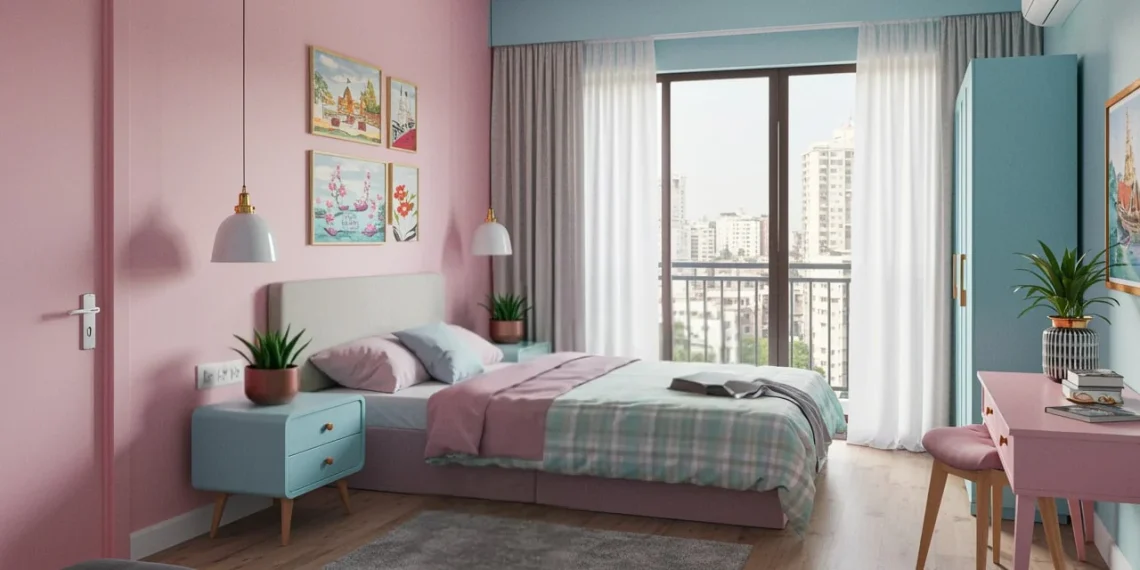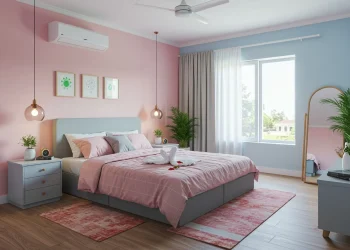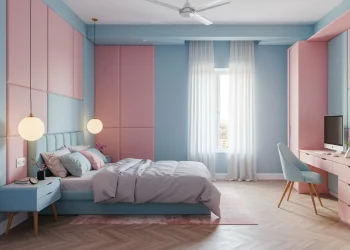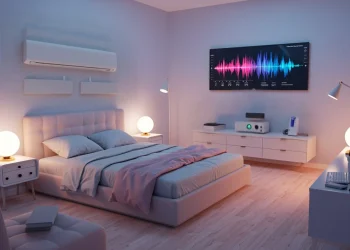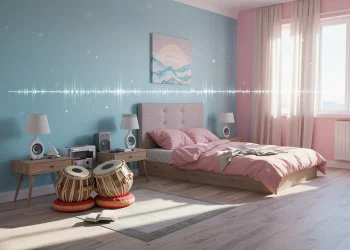Living in a modern apartment shouldn’t mean sacrificing the ancient wisdom of Vastu Shastra for your bedroom. While traditional Vastu principles were designed for independent homes with optimal orientations, today’s urban reality presents unique challenges that require creative, practical solutions. The good news? You can still create a harmonious vastu apartment bedroom that promotes restful sleep and positive energy, even within the constraints of contemporary living spaces.
Many apartment dwellers feel caught between honoring traditional Vastu guidelines and working within the limitations of pre-designed layouts. The key lies in understanding that Vastu is ultimately about creating balance and harmony in your living space, and this can be achieved through thoughtful adaptations rather than rigid adherence to traditional rules.
The Reality of Modern Apartment Layout Challenges
Contemporary apartment living presents several fundamental challenges when applying traditional Vastu principles to bedroom design. Unlike traditional homes that were planned with Vastu considerations from the ground up, modern apartments are typically designed with space efficiency and cost optimization as primary concerns, often leaving Vastu compatibility as an afterthought.
Fixed Structural Elements Create Immovable Obstacles
The most significant challenge apartment dwellers face is the inability to modify structural elements. Your bedroom’s position within the apartment, the direction your building faces, and the placement of doors and windows are predetermined factors that cannot be changed. Traditional Vastu recommends specific directions for different rooms, but when you’re working with a fixed layout, flexibility becomes essential.
For instance, if your modern vastu bedroom is located in the northwest corner of your apartment – traditionally considered less ideal for the master bedroom – you cannot simply relocate it. However, this doesn’t mean you’re destined for poor sleep or negative energy. Instead, it means working creatively within these constraints to optimize the space you have.
Limited Space Restricts Furniture Placement Options
Modern apartments often feature compact bedrooms where furniture placement is dictated more by available space than by Vastu principles. Traditional guidelines suggest placing the bed in specific positions relative to walls and directions, but when your bedroom is barely large enough for a queen-size bed and a wardrobe, you may find yourself with only one viable furniture arrangement.
This spatial constraint becomes particularly challenging when dealing with built-in wardrobes, attached bathrooms, or irregularly shaped rooms. Many apartments feature bedrooms with awkward layouts – perhaps L-shaped or with slanted walls due to architectural design choices that prioritize maximizing the number of units over individual room optimization.
Shared Walls and Noise Pollution Affect Energy Flow
Unlike independent homes, apartments involve shared walls with neighbors, which can impact both energy flow and practical considerations like noise levels. The bedroom that shares a wall with your neighbor’s kitchen or bathroom may face challenges related to unwanted sounds and energy disturbances that traditional Vastu texts don’t specifically address.
Additionally, apartments often have bedrooms that face busy streets, other buildings, or common areas rather than the peaceful, open spaces that traditional Vastu principles assume. This urban reality requires adaptive solutions that account for external noise, limited privacy, and restricted views.
Electrical and Plumbing Infrastructure Limitations
Modern apartments come with predetermined electrical outlets, lighting fixtures, and sometimes built-in air conditioning units whose placement cannot be easily modified. Traditional Vastu guidelines about avoiding electrical equipment in certain bedroom areas become challenging to follow when these elements are hardwired into the apartment’s infrastructure.
Similarly, many apartments feature attached bathrooms whose positioning relative to the bedroom may not align with traditional Vastu recommendations. When the bathroom door opens directly into the bedroom or when plumbing runs through bedroom walls, conventional wisdom requires practical adaptation.
Creative Solutions for Non-Ideal Bedroom Orientations
When your apartment bedroom doesn’t align with traditional Vastu orientations, several creative strategies can help optimize the energy flow and create a restful environment that still honors ancient principles while working within modern constraints.
Redirect Energy Flow with Strategic Mirror Placement
Mirrors can serve as powerful tools for redirecting and enhancing energy flow in a vastu apartment bedroom with challenging orientations. When placed strategically, mirrors can create the illusion of extending space in beneficial directions or reflecting positive energy from more auspicious areas of your home.
For bedrooms facing less favorable directions, consider placing a mirror on the wall opposite to your bed that reflects a view of a more positive direction or pleasant outdoor scenery. However, ensure the mirror doesn’t directly reflect the bed while you sleep, as this can create restless energy according to both Vastu and modern sleep science.
Use Color Psychology to Compensate for Directional Challenges
Colors carry significant energy in Vastu philosophy, and they can be used strategically to balance orientational disadvantages. For a northeast-facing bedroom that may feel too bright in the early morning, incorporate deeper, more grounding colors like forest green or navy blue to create a sense of stability and rest.
Conversely, if your bedroom faces west and lacks natural morning light, warmer colors like soft yellows, peachy tones, or light oranges can infuse the space with energizing qualities during daylight hours while still maintaining a restful atmosphere for sleep.
Create Artificial Directional Emphasis Through Lighting
Lighting can simulate beneficial directional energies even when your room’s natural orientation isn’t ideal. Use soft, warm lighting on the eastern wall of your bedroom to encourage the energy of new beginnings and fresh starts, regardless of which direction your room actually faces.
Incorporate different types of lighting – ambient, task, and accent – to create layers that can be adjusted based on the time of day and your activities. This allows you to artificially create the energy patterns that traditional Vastu associates with beneficial directions.
Establish Clear Zones Within Multi-Purpose Spaces
Many modern apartments feature bedrooms that must serve multiple functions – sleeping, working, exercising, or storage. Create distinct energetic zones within your modern vastu bedroom using furniture arrangement, area rugs, or subtle room dividers.
Designate the sleeping area as sacred space with minimal electrical equipment and maximum serenity, while allowing other necessary functions to occupy areas closer to the door or window. This zoning approach honors the Vastu principle of purposeful space allocation even within limited square footage.
Compromise Strategies for Space-Constrained Homes
Small apartment bedrooms require intelligent compromise strategies that maintain the spirit of Vastu principles while acknowledging spatial realities. These approaches focus on maximizing the positive energy flow possible within your available space rather than achieving perfect traditional compliance.
Prioritize the Most Impactful Vastu Elements
When space constraints make it impossible to implement all traditional Vastu recommendations, focus on the elements that will have the greatest impact on your sleep quality and overall well-being. Bed placement relative to the door, ensuring your head doesn’t point toward the bathroom, and maintaining clear pathways around the bed often take precedence over less critical factors.
Research suggests that bed placement significantly impacts sleep quality regardless of cultural background, making this a priority area where Vastu wisdom aligns with modern sleep science. Position your bed so that you can see the door without being directly in line with it, creating both security and proper energy flow.
Embrace Vertical Solutions for Storage and Decor
When floor space is limited, utilize vertical space to implement Vastu-friendly solutions. Wall-mounted storage reduces clutter at floor level, improving energy circulation, while vertical gardens or artwork can introduce natural elements that traditional Vastu values.
Tall, narrow furniture pieces maintain the openness that Vastu principles emphasize while providing necessary functionality. This approach prevents the cramped feeling that can disrupt peaceful energy, even in genuinely small spaces.
Create Symbolic Representations of Ideal Conditions
When you cannot achieve ideal physical conditions, symbolic representations can maintain the energetic intent of Vastu principles. A small fountain or water feature image in the northeast corner can represent the water element’s beneficial properties, even if a full water feature isn’t possible in your apartment.
Similarly, crystals, plants, or artwork representing the five elements can be strategically placed to balance energy without requiring significant space or structural modifications. These symbolic touches honor traditional principles while remaining practical for apartment living.
Interior Design Tricks to Enhance Directional Energy
Modern interior design offers numerous tools for enhancing directional energy that complement traditional Vastu principles while remaining suitable for contemporary apartment living.
Layer Textures to Create Energetic Depth
Different textures carry different energetic qualities that can enhance your vastu apartment bedroom’s directional strengths. Smooth, flowing fabrics like silk or cotton can encourage gentle energy movement, while rougher textures like jute or linen can provide grounding energy in areas where stability is needed.
Combine textures thoughtfully throughout your bedroom to create energetic layers that support different aspects of rest and rejuvenation. Soft bedding, textured throw pillows, and varied window treatments can work together to create a rich sensory environment that promotes deep, restful sleep.
Incorporate Natural Elements Through Accessible Means
Traditional Vastu emphasizes the importance of natural elements, but apartment living often limits access to extensive natural features. Create connections to nature through indoor plants, natural materials in furniture and decor, and artwork depicting natural scenes.
Even small touches like wooden picture frames, stone decorative objects, or a single well-chosen plant can significantly impact your bedroom’s energy. These natural elements provide grounding and connection to the earth’s rhythms, supporting the restorative processes that occur during sleep.
Use Geometric Patterns to Direct Energy Flow
Geometric patterns in bedding, rugs, or wall art can subtly direct energy flow according to Vastu principles. Flowing, curved patterns encourage gentle energy movement, while more structured patterns can provide stability and grounding.
Choose patterns that resonate with your bedroom’s specific needs and directional challenges. For rooms that feel too active or energetic, incorporate more geometric, structured patterns. For spaces that feel stagnant, flowing, organic patterns can encourage better energy circulation.
Real Apartment Bedroom Makeover Case Studies
Case Study 1: The Northwest Corner Challenge
Priya, a software engineer in Mumbai, struggled with her modern vastu bedroom located in the northwest corner of her 2BHK apartment. Traditional Vastu suggests this location can lead to instability and restless sleep. Her bedroom also featured a large window facing a busy street and limited space for traditional furniture arrangements.
The solution involved creating a strong eastern energy emphasis despite the room’s northwestern location. We introduced warm, golden lighting on the eastern wall, placed a small crystal in the northeast corner of the room, and used deep blue bedding to provide grounding energy. A flowing white curtain filtered the street noise and harsh light while maintaining the window’s beneficial aspects.
The result was dramatically improved sleep quality and a sense of greater stability in her daily routine. Priya reported feeling more grounded and experiencing fewer sleep disruptions within three weeks of implementing these changes.
Case Study 2: The Shared Wall Dilemma
Rajesh and Meera’s master bedroom in their Bangalore apartment shared a wall with their neighbor’s kitchen, creating noise issues and what they perceived as negative energy transfer. Their compact 10×12 foot bedroom offered limited options for bed placement, with built-in wardrobes determining much of the room’s layout.
The transformation focused on creating energetic barriers and enhancing positive energy flow within the existing constraints. A wooden headboard was installed against the shared wall, providing both sound insulation and energetic protection. Strategic placement of plants near the shared wall helped filter negative energy, while soft, indirect lighting created a peaceful atmosphere that countered any disruptive influences.
The couple experienced significant improvements in sleep quality and relationship harmony, demonstrating how thoughtful adaptations can overcome challenging structural limitations.
Case Study 3: The Multi-Purpose Room Challenge
Anita’s studio apartment required her bedroom to serve multiple functions within a single 200 square foot space. Traditional Vastu principles seemed impossible to implement given the need for sleeping, working, and storage areas within the same room.
The solution involved creating distinct energetic zones using furniture placement and visual separators. The sleeping area was positioned to maintain Vastu-friendly bed placement while incorporating a folding screen that could separate the work area during sleep hours. Specific lighting for each zone allowed the space to transform energetically based on its current use.
This approach honored Vastu principles while acknowledging modern urban living realities, resulting in improved sleep quality and greater productivity in both work and rest activities.
Conclusion: Harmonizing Ancient Wisdom with Modern Living
Creating a vastu apartment bedroom in today’s urban environment requires creativity, flexibility, and a deep understanding of both traditional principles and contemporary constraints. The key lies not in perfect adherence to ancient rules, but in capturing the essence of what makes Vastu effective: creating spaces that promote harmony, rest, and positive energy flow.
Remember that Vastu principles were developed to support human well-being, and this goal remains achievable even within the limitations of modern apartment living. By focusing on practical adaptations that honor traditional wisdom while working within contemporary constraints, you can create a bedroom environment that supports restful sleep and overall wellness.
Ready to transform your apartment bedroom using these modern vastu bedroom principles? Start with one or two small changes that feel most relevant to your space and gradually build upon them. Your journey toward better sleep and positive energy doesn’t require a complete home renovation – sometimes the most powerful transformations begin with the smallest, most thoughtful adjustments.
